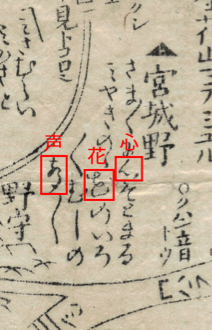Reading Japanese maps and marketing practices 1 - solution

Very common kanji characters such as 心、花 or 声 are usually difficult to read in old written texts. Edo-period writers used to write these kanji characters with rapid brushstrokes, resulting in elongated and distorted shapes that readers nowadays will find them difficult to identify without special training or tools. To identify an unknown kanji character in a source, you can use kuzushiji dictionaries. One of the most widely used is the Kuzushji Yōrei Jiten (くずし字用例辞典). An alternative to printed dictionaries are online databases that allow specialists to check the different ways of writing a kanji character by comparing several digitized documents. You can visualize the different ways of writing the kanji in this poem by accessing the Nihon Kuzushiji Deeta-setto (日本古典籍くずし字データセット) database created by the Center for Open Data in the Humanities using the following link:
http://codh.rois.ac.jp/char-shape/search/
Kuzushiji databases and the Kuzushji Yōrei Jiten are convenient tools to identify kanji in a written source, if you have an approximate idea of what kanji you are looking for. In the case of finding a written kanji character that you are unable to identify, an alternative way is to use the Kuzushiji kaidoku jiten (くずし字解読辞典) dictionary. This dictionary classifies the different kanji characters by the shape of their kuzushiji forms. It might allow you to identify a tricky kanji character when you are unable to identify it from its shape or the context of the text.
